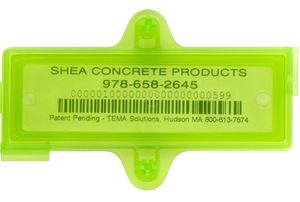Four manufacturers of precast concrete structures are using an RFID system to track the structures as they are made, inspected, stored and shipped to a construction site. The system’s developer, International Coding Technologies (ICT), says it provides the companies with an electronic quality-control trail as well as better management of inventory in their yards.
Phoenix Precast is using the system to gain National Precast Concrete Association (NPCA) certification allowing it to be a supplier to projects that require such certification from precast concrete manufacturers. Although certification can be accomplished with a pen and paper trail, an electronic system makes record keeping more accurate and easier to manage, says Phoenix Precast’s assistant general manager, Peter Scott. The system allows Phoenix’s quality-control officers to read passive UHF RFID tags on the concrete products as well as on the steel forms in which they are molded, creating an electronic data file that chronicles when the product was made, when it was inspected and by whom. Phoenix Precast began tagging its products in January and currently has about one-third of its inventory tagged, Scott says. By the first quarter of 2009, he hopes to have all products tagged and to apply for NPCA certification.
E.F. Shea Concrete began using the system about six months ago, says the company’s manager, Greg Stratis, and has since seen a significant drop in labor hours spent keeping records for quality control. E.F. Shea, which already had NPCA certification, had been using pen and paper to track quality-control inspections during the manufacturing process, which then had to be manually input into the system.
Precast manufacturers make concrete structures for bridges, roadways, manholes, stairways or burial vaults, and haul the finished pieces to the construction sites or cemeteries. Quality control is accomplished by visually inspecting an item as it is being made. If the inspections are recorded, either electronically or on paper, that data record qualifies a company for NPCA certification. Increasingly, Scott says, government projects and cemeteries require precast vendors to have such a certification.
In addition to using the RFID for quality control, Phoenix and E.F. Shea will also use it for inventory control, assisting the companies in locating items in their yard, where they are stored prior to being transported by truck to a customer.
ICT provides RFID solutions specifically for the precast industry, says Tom Tilson, the company’s CEO. Tilson explains that his company had identified a need for better tracking of concrete structures, which traditionally is done with paper and pencil. “I thought, Why not use bar codes?” Tilson says, although he later found out that RFID technology made more sense because bar-coded labels were more likely to get damaged. “Once we got it into the field, we found that bar coding wasn’t going to work. Concrete precasting is a very rough environment.”
About a year ago ICT began providing an RFID-based solution that allowed electronic tracking of concrete structures and linking of those structures to steel forms using rugged RFID tags and handheld readers.With the ICT system, says Tilson, when a concrete structure is first ordered, precast manufacturers input data about the order. The structures are cast in a steel mold or “form.” The forms are tagged with a rugged plastic-encased Cast-a-Code RFID tag, containing a UPM Raflatac DogBone EPC Gen 2 inlay encoded with a unique ID number linked to data about the form in the back-end system, and a matching bar-code on the front of the 1.5- by 5-inch tag.
Phoenix Precast manufactures, among other things, concrete septic tanks, manholes and specialty box products. Before casting the concrete, Phoenix’s quality-control officers inspect the steel form and use a Motorola MC9090-G handheld mobile computer with a built-in RFID interrogator to read the form’s tag, indicating when it was inspected and by whom. That data is sent via a Wi-Fi connection to Phoenix Precast’s back-end system using ICT’s TrackCon software. At the time the concrete is poured, a Phoenix worker attaches another RFID tag inside the form. There are two small holes in the inside of the form where two knobs on the tag are inserted. After the concrete hardens and is removed from the form, the tag knobs break off and the tag remains permanently embedded in the concrete.
During the casting process, quality-control officers inspect the products as well as read the Cast-a-Code RFID tag, linking it to its steel form, and respond to prompts on the handheld device as to what kind of structure is being manufactured. By the time a concrete structure is separated from its form, the Cast-a-Code tags on both the structure and the form have been read two or three times. Typically, the company also puts the product through some finishing process. The structure is then moved by forklift to a storage yard.
A precast manufacturer could also equip its forklift truck with Alien Technology RFID interrogators to capture the ID number on the tag as soon as the vehicle comes close to the structure. The forklift’s interrogator would continue to read the tag until the structure has been placed in storage. Then, a GPS function in the reader would determine the zone in which the structure has been placed and send that information to the back-end system when the forklift reader stops receiving transmission from the tag.
When the item is delivered to a customer, the truck driver can use the MC9090-G’s RFID interrogator or bar-code scanner to capture the structure’s tag ID number, indicating in the system that the item has been delivered.
In Phoenix’s case, Scott says, the company intends to use a handheld RFID reader once a month to capture all inventory in the storage yard, which he says is many acres in size and includes hundreds of assorted concrete products stacked and waiting to be shipped. Alternatively, inventory could be accomplished on a monthly basis with an RFID reader with a built-in GPS function that would determine each RFID tag’s location in the storage yard, Scott says, although the company is not yet using such a device.
E.F. Shea is using the system in the same manner that Phoenix is, but also intends to install RFID readers on its forklifts in the future, says Stratis, E.F. Shea’s manager. Once the company is equipped with forklift readers, he expects the system to display data about the location of each piece based on where it was unloaded by a forklift. In addition, he says, once a year an E.F. Shea employee will walk through the yard with a handheld reader to confirm the location of concrete pieces.
Because E.F. Shea had been recording inspection data by hand prior to using RFID, Stratis says he has already seen a return on investment based on time savings. “The reduction of manpower alone will give me a savings,” he says.
All serial numbers on the Cast-a-Code tags begin with three digits that identify the precast manufacturer. In that way, Tilson says, a third party, such as a municipality, can scan the RFID inlay or bar code and identify which manufacturer created the structure. The RFID tags can be read through 12 inches of concrete, Tilson says, making it possible for someone to use an RFID reader to capture the identity of a specific piece within an assembled bridge or other structure. The system also allows manufacturers to link data about the piece to data about the concrete batch that it was built from.



